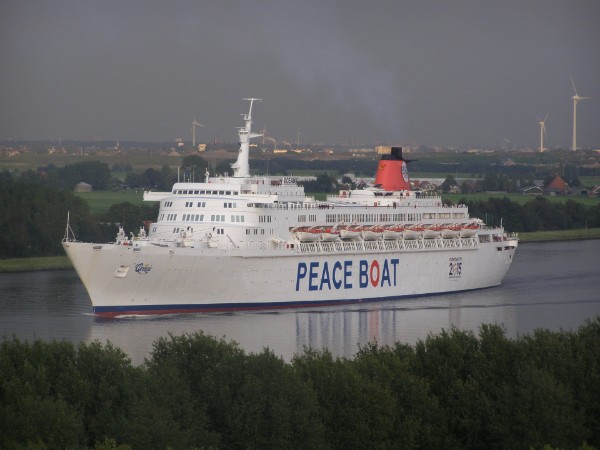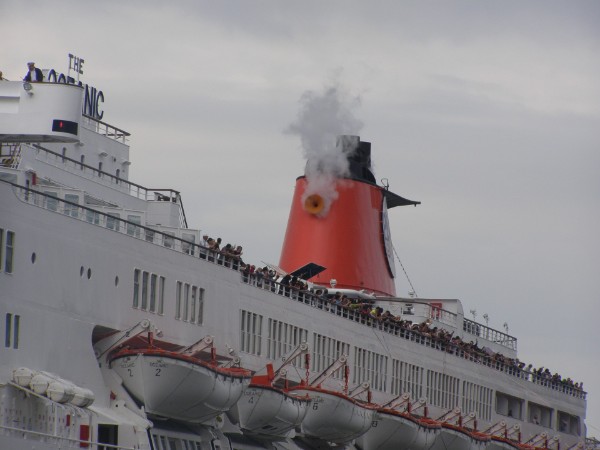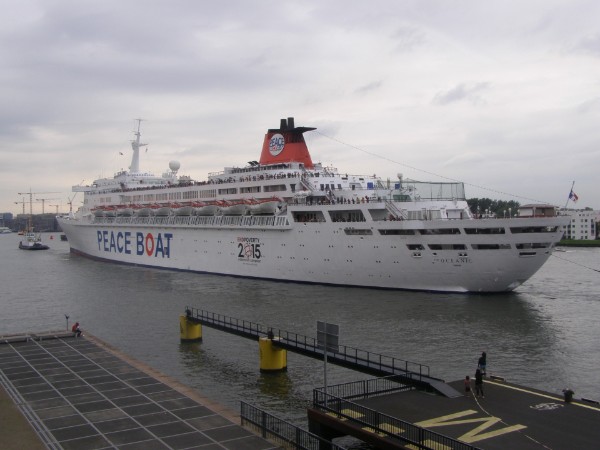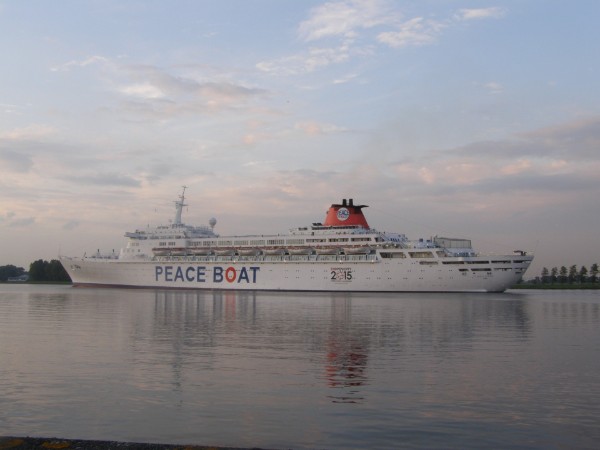The Oceanic

A very well-known name is shipping history, without the 'The'-part of course. In 1870, the White Star Line launched their first Oceanic, a ship that sailed between 1871 and 1896. In 1899, this ship was followed by a new Oceanic for the White Star Line and this time, she was the largest oceanliner in the world, measuring no less then 17.272 tons. This Oceanic had also been part of the almost collission between three ships in Southampton, the New York of Inman Line and the Oceanic and Titanic of the White Star Line when the last of these three ships set sail for her fatal maiden voyage in april 1912. In september 1914, the second Oceanic was lost on the rocks of the Shaalds of Foula near the Shetland Islands. In 1928, White Star Line started building a thirth Oceanic, and she would actually be the first ship in the world exceeding 1000 foot in lenght. Although partially complete, because of the financial problems of the Royal Mail company in these years, who owned the White Star Line at the time, work was halted and later cancelled.

The company Home Lines originated from Genoa in 1946, and the major shareholders were the Italian Consulich Line and the Swedish American Line. In this year, Home Lines bought their first ship, the former Bergensfjord from Norwegian America Line. They renamed the ship Argentina and she was used for the intended Home Lines route between Genoa and South America. From 1949 onwards, after the line had bought some more ships, mostly former Swedish American liners, the route between Genoa and New York was added, slowly replacing the South American route. Also, routes between Germany and New York and Southampton and Canada were started up. Home Lines tried to fill the gap that was opened for services from the now mostly ship-less Italy and Germany after they lost the second world war. From 1955 onwards, Home Lines also started cruising from New York to the Bahamas. Just as all other companies, cruising slowly started to be their main objective. In 1958, transatlantic services to New York were abandonned and in 1961 services to Canada were discontinued.
It was also during these years that Home Lines ordered their first newbuilt, a ship that was intended for the Cuxhaven to New York service and so she was designed as an ocean liner, although it became clear early on that cruising would be her most important market. She thus became a true dual-purpose liner, with many design feautures from the golden age of liner-travel. The ship was built at the Cantieri Riuniti dell' Adriatico wharf at Montefalcone, Italy. Her yardnumber was 1876 and she would measure 27.645 tons. She has a lenght of 238,44 meters, a width of 29,42 meters and a draft of 8,60 meters. She was to be pretty fast, a true oceanliner feauture, she could achieve 27,25 knots maximum although her service speed was somewhere around 26 knots. She had a total passenger capacity of 1600 and a crewcapacity of 560. Her machinery consists of four steam turbines and she is driven by two propellers. Responsible for the design of the ship were mister Charalambos Keusseuglou, the vice-president of Home Lines, and Mr. Constanzi, who was also responsible for the design of the Lloyd Triestino liners Galileo Galilei and Guglielmo Marconi. She was a very innovative ship, introducing the still used magrodome that could be retracted over the ships outer pools so they could also be used in bad weather. Also, the ship had a different placing of the lifeboats then traditional ships, lower on the ships hull then the older placing on top of ships.

The ships steam whistle still works fantasticly after 46 years! In front of her funnel, her Japanese passengers are lined up to cheer at the (rather small) crowd waving the ship goodbye from the terminal at Amsterdam.
On the 15th of january 1963 the ship was launched as Oceanic, although it was intended to launch her one week earlier. This was postponed, because of the unusally cold weather in Italy at the time. During her fitting-out period, Home Lines ended transatlantic services and as a result the ship was thus never used as a transatlantic liner. Her first service as the new Home Lines flagship was a voyage between Genoa and New York, departing at the 31st of march 1965. Only 200 passengers were carried. At the 10th of april when the ship was close to Halifax, in the theater aboard the movie The Unsinkable Molly Brown with Debby Reynolds was screened. This movie was of course about Molly Brown, passenger aboard Titanic and showing a movie like this at almost exact the same spot where the great ship sank in 1912 may be called questionable at least... After arriving at the 14th of april in New York she took up station from there, departing on her first 7-day cruise to the Bahamas at the 24th of april. She operated this cruiseservice together with her older fleetmate, the Homeric. Originally, this ship had been the 1931-built Matson liner Mariposa, built for Hawaiian service from Los Angeles and San Fransisco. She sailed for Home Lines from 1953 onwards. Oceanic's arrival in New York was a little disrupted by a protest organized by the National Maritime Union about the loss of jobs due to foreign-flagged cruiseships. Of course the ship was Italian owned and not American, staffed by Italians and foreigners like many ships before her. But the NMU saw it already coming, the end of US flagged shipping was at the horizon when flags of convenience were flown more and more ending a period when the USA had its flag on several oceanliners also. Furthermore, the arrival of Oceanic in New York was a cause for celebration. Fireboats provided watery curtains, airplanes with reporters were flying overhead and many salutes from ships in port were there also to greet the new ocean liner. Among them were the Italian Leonardo Da Vinci, the Norwegian Viking Princess and the French France.
In wintertime, Oceanic sailed cruises in the Caribbean and she became one of the most popular cruiseliners of her day. Mostly, the ship sailed with full capacity. In 1982, Home Lines introduced their new flagship Atlantic and they ordered another new ship to be delivered in 1986, the new Homeric. Just before this ship entered service, Oceanic was sold to Premier Cruise Line, a company that sailed with older tonnage, offering their passengers a classic cruise experience.

For Premier Cruises, Oceanic's hull was repainted in red, the Premier Cruises trademark. For them, she was renamed also, she was now the StarShip Oceanic. She started sailing short cruises from Port Canaveral to the Bahamas, well known territory for her. As a special package, the cruise could be combined with a stay at the Walt Disney World. For Premier, she also was often referred to and advertized as the 'Big Red Boat'. In the year 2000, this was the inspiration for a new naming strategy of the companies ships, or boats, when she was renamed Big Red Boat 1. But this was only for a very short while, because Premier Cruises was declared bankrupt in september of that same year and the ship was detained at Freeport at the Bahamas and put up for sale.

At the 30th of december 2000, the ship was bought by Pullmantur Cruises from Spain and renamed Oceanic. She was refurbished in Cadiz and lost the big red hull too. In may of 2001, the ship resumed cruising from the port of Barcelona in the Mediterranean Sea. She again became a very popular ship, being one of the last traditional cruiseliners in the world. Pullmantur updated her over time so she would be ready when the new 2010 SOLAS regulations were required. Although she was modernized because of this, Pullmantur sold her in march of 2009 to the Japanese Peaceboat organisation. Originally, it was intended that she would end the season with Pullmantur, but this did not happen as she was delivered as soon as april 2009 to her new owners.

Already on the 23rd of april 2009, she entered service for the Peaceboat organisation, departing from Yokohama on a round-the-world voyage. This was in fact the 66th voyage by the organisation, dubbed the 'Global Voyage for Peace'. The goal is to bring awareness for world peace around the world. During the voyage, Scandinavia was one of the main areas for the first time, with the goal of learning about the northern European education-possibilities and welfare. In the first week of may 2010, Oceanic was attacked by pirates off the coast of Yemen, not only with machineguns but also with granades. Sailing a zig-zag course and using high-preasure water hoses, together with the help of NATO, the pirates were defeated before they could board the ship. It shows that it is in this part of the world no guarantee for safety when you are sailing at even a large ship like the Oceanic. It also showed that awareness for peace and a big sign on your ship starting with the word 'Peace' is also not going to make any change soon in this hostile strait. At the very end of her carreer, the name of the ship was altered to The Oceanic, so that is the reason she is featured on this website under this name.
The ship was laid up a the end of 2011 and although it was hoped she would be saved in some way, she was sold to Chinese interests, and at the end of 2012, she was towed to China to be broken up.

All pictures were taken during her passage throught the Northsea Canal at the 4th of september 2011.

